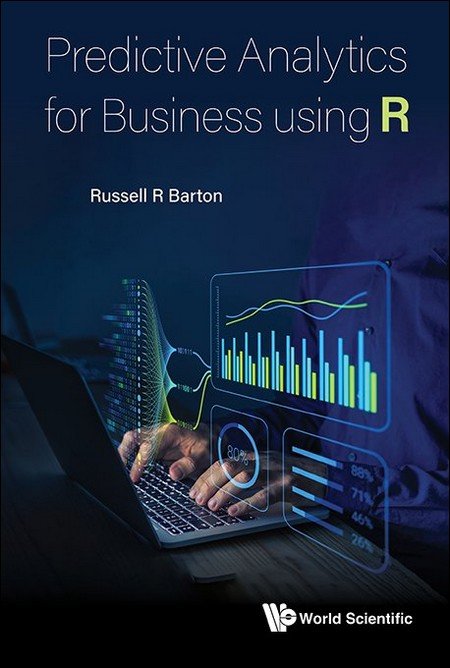The fields of mathematical statistics, statistical graphics, computer science and operations research have created the rich set of methods now called Analytics. Often analytics is characterized along three poles: descriptive analytics (what do data tell us), predictive analytics (what can be forecast based on the data, and with what certainty), and prescriptive analytics (how can the data inform changes to improve system performance).
This book focuses on the second pole, predictive analytics. The areas of predicting a number, a class, and dynamic behavior are distinct, with different methods. This text has three parts based on these areas. Topics in predicting a number include simple and multiple linear regression, transformation of variables, analysis of observational data via cross-validation, the generalized linear model, designed experiments, and Gaussian process and neural network regression. Classification methods include neural networks, logistic regression, k-nearest neighbor, and linear discriminant analysis. Methods for predicting dynamic behavior include trend analysis, time series analysis and discrete-event dynamic simulation.
Characterizing prediction uncertainty is a key focus of this text. The text provides analytic methods appropriate to each area, with an explicit process for applying such methods. Case data with corresponding R code are used to illustrate each method.
Predictive Analytics for Business using R is designed for a hybrid class structure. Class sessions can be a blend of lecture format and flipped classroom case analyses. In a two-meetings-per-week fifteen-week structure, one day per week would be devoted to explaining methodology and presenting a case study, with the second day focused on coaching. Given the case structure, the text does not contain homework problems. Instead, at the end of each chapter there are links to cases posted online.
Request Inspection Copy
Sample Chapter(s)
Preface
Chapter 1: Introduction
Contents:
- Getting Started:
- Introduction
- The R Programming Environment
- Predicting a Number:
- Linear Regression
- Regression Under the Data-Adaptive Research Paradigm
- Nontraditional Regression (Machine Learning)
- Predicting a Class:
- Classification for Predictive Analyticss
- Predicting Dynamic Behavior:
- Trendline and Time Series Analysis for Forecasting
- Simulating Random Values
- Building Discrete-Event Simulation Models
- Prediction with Discrete-Event Simulation Models
Readership: Advanced undergraduates, Master's students in business, accounting, engineering, statistics or computer science, as well as practitioners in business analytics, business consulting, industrial engineering and operations research.
"Predictive Analytics for Business using R is a timely, comprehensive, and innovative monograph on a key topic in today's research and business activities. In a world where individuals, corporations, and institutions are increasingly looking for quantitative support for decision-making, under the disruptive influence of artificial intelligence, the book is a cornerstone for anyone wanting to use analytics. For students, the book gently and wisely guides them on a journey from the basics to the more advanced aspects of predictive analytics. For educators, the book is an ideal teaching aid, given its extensive and careful selection of topics and the variety of tools it illustrates. For more experienced professionals, the book offers a wealth of fresh perspectives and guides them from framing analytics questions to communicating managerial insights. The coverage of topics is extensive: from a very clear introduction to the software R, to regression and classification with machine learning tools, up to the details of stochastic simulation."
Emanuele Borgonovo (PhD, MIT)
Director, Department of Decision Sciences, Bocconi University
Co-Editor-in-chief, European Journal of Operational Research
Russell Barton is Distinguished Professor of Supply Chain and Information Systems in the Smeal College of Business and a Certified Analytics Professional. He received his PhD in operations research from Cornell University. He began his career as an analytics consultant at RCA, followed by similar roles at Econ, Inc., The Mentoris Company, and Mathtech, before returning to RCA for eight years. Projects included predicting the impact of telecommuting on urban structure, modeling exoffender post-release behavior, analyzing workers' compensation claims for hundreds of thousands of records, constructing risk models for self-insurance options, simulating semiconductor manufacturing operations, predicting satellite communications reliability, measuring videodisc quality, characterizing image errors in video monitors, and visual representations of experiment results.
His academic career began at Cornell University as a Visiting Associate Professor in the School of Operations Research and Industrial Engineering, and Laboratory Director for the Cornell Computational Optimization Project. Following Cornell, he was Professor of Industrial Engineering at Penn State. From 1998–1999 he was a Visiting Professor at Ècole Centrale Paris in the Production and Logistics Research Laboratory. He moved to Penn State's Smeal College of Business in 2002, and served as Associate Dean for Research and MS/PhD Programs, Co-Director of the Master's of Manufacturing Management degree program, and as Senior Associate Dean for Research and Faculty. served as Program Director for Manufacturing Enterprise Systems and Service Enterprise Systems at the US National Science Foundation from 2010–2012, and as an analytics consultant to firms including Fluke, Ford, GE, GM, Kodak, Lockheed-Martin, Textron, and Xerox.
Supplementary Material
Please note that supplementary materials of the cases and case data are provided by the author in the link below:
https://drive.google.com/drive/folders/17dqhqUo-tkAXlSrLgkhXbqC_ErLJy0S2
You will be redirected to the Google Drive of the author of Predictive Analytics for Business using R, which is maintained independently by the author.
While World Scientific strives to ensure that the content we link to is relevant, we do not have control over, nor do we assume responsibility for, the content, availability, or updates on the author's Google Drive. The inclusion of this link does not imply endorsement by World Scientific of the linked content.
Please also note that:
Any information you provide or actions you take on the external site are governed by the privacy and security policies of the external site.
World Scientific is not liable for any issues, losses, or damages arising from your use of the external link.
If you have any questions or concerns about the content found on the author's Google Drive, please contact the author directly.
Sample Chapter(s)
Preface
Chapter 1: Introduction




